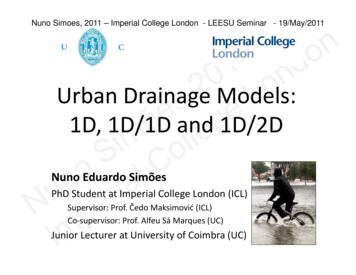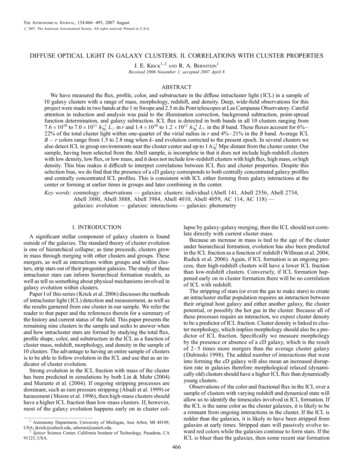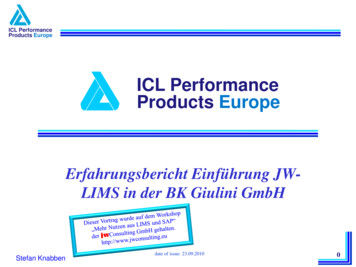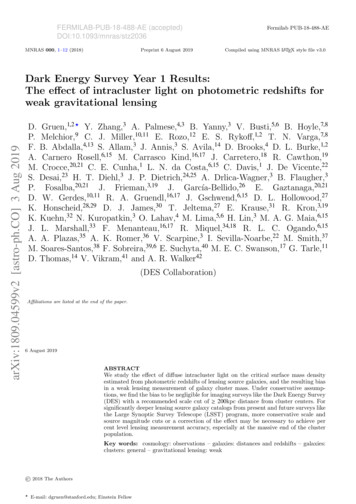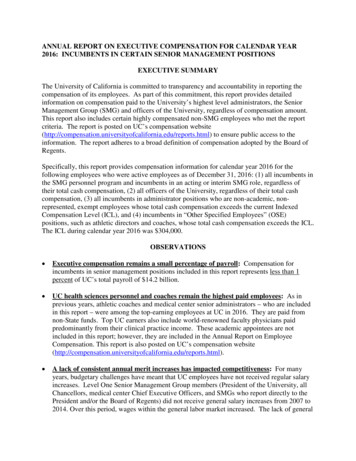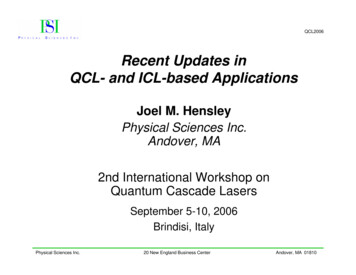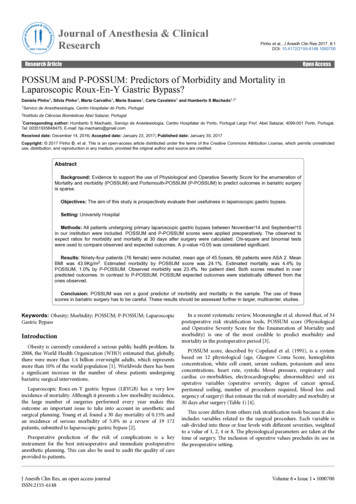
Transcription
Journal of Anesthesia & ClinicalResearchl Researchicaal of AurnneJoesia & ClinsthISSN: 2155-6148Pinho et al., J Anesth Clin Res 2017, 8:1DOI: 10.4172/2155-6148.1000700Open AccessResearch ArticlePOSSUM and P-POSSUM: Predictors of Morbidity and Mortality inLaparoscopic Roux-En-Y Gastric Bypass?Daniela Pinho1, Sílvia Pinho1, Marta Carvalho1, Maria Soares1, Carla Cavaleiro1 and Humberto S Machado1,2*1Servicode Anesthesiologia, Centro Hospitalar do Porto, Portugal2Institutode Ciências Biomédicas Abel Salazar, Portugal*Correspondingauthor: Humberto S Machado, Serviço de Anestesiologia, Centro Hospitalar do Porto, Portugal Largo Prof. Abel Salazar, 4099-001 Porto, Portugal,Tel: 00351935848475; E-mail: hjs.machado@gmail.comReceived date: December 14, 2016; Accepted date: January 23, 2017; Published date: January 30, 2017Copyright: 2017 Pinho D, et al. This is an open-access article distributed under the terms of the Creative Commons Attribution License, which permits unrestricteduse, distribution, and reproduction in any medium, provided the original author and source are credited.AbstractBackground: Evidence to support the use of Physiological and Operative Severity Score for the enumeration ofMortality and morbidity (POSSUM) and Portsmouth-POSSUM (P-POSSUM) to predict outcomes in bariatric surgeryis sparse.Objectives: The aim of this study is prospectively evaluate their usefulness in laparoscopic gastric bypass.Setting: University HospitalMethods: All patients undergoing primary laparoscopic gastric bypass between November/14 and September/15in our institution were included. POSSUM and P-POSSUM scores were applied preoperatively. The observed toexpect ratios for morbidity and mortality at 30 days after surgery were calculated. Chi-square and binomial testswere used to compare observed and expected outcomes. A p-value 0.05 was considered significant.Results: Ninety-four patients (76 female) were included, mean age of 45.5years, 66 patients were ASA 2. MeanBMI was 43.9Kg/m2. Estimated morbidity by POSSUM score was 24.1%. Estimated mortality was 4.4% byPOSSUM, 1.0% by P-POSSUM. Observed morbidity was 23.4%. No patient died. Both scores resulted in overpredicted outcomes. In contrast to P-POSSUM, POSSUM expected outcomes were statistically different from theones observed.Conclusion: POSSUM was not a good predictor of morbidity and mortality in the sample. The use of thesescores in bariatric surgery has to be careful. These results should be assessed further in larger, multicenter, studies.Keywords: Obesity; Morbidity; POSSUM; P-POSSUM; LaparoscopicGastric BypassIntroductionObesity is currently considered a serious public health problem. In2008, the World Health Organization (WHO) estimated that, globally,there were more than 1.4 billion overweight adults, which representsmore than 10% of the world population [1]. Worldwide there has beena significant increase in the number of obese patients undergoingbariatric surgical interventions.Laparoscopic Roux-en-Y gastric bypass (LRYGB) has a very lowincidence of mortality. Although it presents a low morbidity incidence,the large number of surgeries performed every year makes thisoutcome an important issue to take into account in anesthetic andsurgical planning. Young et al. found a 30 day mortality of 0.15% andan incidence of serious morbidity of 5.8% in a review of 19 172patients, submitted to laparoscopic gastric bypass [2].Preoperative prediction of the risk of complications is a keyinstrument for the best intraoperative and immediate postoperativeanesthetic planning. This can also be used to audit the quality of careprovided to patients.J Anesth Clin Res, an open access journalISSN:2155-6148In a recent systematic review, Moonesinghe et al. showed that, of 34postoperative risk stratification tools, POSSUM score (Physiologicaland Operative Severity Score for the Enumeration of Mortality andmorbidity) is one of the most credible to predict morbidity andmortality in the postoperative period [3].POSSUM score, described by Copeland et al. (1991), is a systembased on 12 physiological (age, Glasgow Coma Score, hemoglobinconcentration, white cell count, serum sodium, potassium and ureaconcentrations, heart rate, systolic blood pressure, respiratory andcardiac co-morbidities, electrocardiographic abnormalities) and sixoperative variables (operative severity, degree of cancer spread,peritoneal soiling, number of procedures required, blood loss andurgency of surgery) that estimate the risk of mortality and morbidity at30 days after surgery (Table 1) [4].This score differs from others risk stratification tools because it alsoincludes variables related to the surgical procedure. Each variable issub-divided into three or four levels with different severities, weightedto a value of 1, 2, 4 or 8. The physiological parameters are taken at thetime of surgery. The inclusion of operative values precludes its use inthe preoperative setting.Volume 8 Issue 1 1000700
Citation:Pinho D, Pinho S, Carvalho M, Soares M, Cavaleiro C, et al. (2017) POSSUM and P-POSSUM: Predictors of Morbidity and Mortality inLaparoscopic Roux-En-Y Gastric Bypass?. J Anesth Clin Res 8: 700. doi:10.4172/2155-6148.1000700Page 2 of 6Physiological ParametersOperative parametersAgeOperative magnitude, numberprocedures, timing of operationCardiacandrespiratoryelectrocardiographic findingssigns,ofBlood lossSystolic arterial pressure, heart ratePeritoneal contaminationGlasgow Coma ScalePresence of malignancyUrea, sodium, potassiumHemoglobin, white cell countPOSSUM - Physiological and Operative Severity Score for the enUmeration ofMortality and morbidity; P-POSSUM - Porthmouth-POSSUM.Table 1: Variables included in the determination of morbidity andmortality by scores POSSUM and P- POSSUM.Several studies have shown that POSSUM overestimates morbiditymainly in low-risk patients [5-7]. P-POSSUM (Portsmouth-POSSUM)uses the same variables but estimates the risk of postoperativemortality through a linear regression model, increasing its predictivevalue [7-9]. However, it is not validated to estimate morbidity and hassome limitations like the underestimation of mortality in the elderlyand in emergent procedures [5]. Both scores were already validated roesophageal (O-POSSUM) surgeries [10].There is a small number of studies looking at risk assessment scoresfor bariatric surgery, and all of them have important limitationsregarding the way in which POSSUM and P-POSSUM were appliedand their sample size, raising questions about their external validity inthe current bariatric practice [11,12].POSSUM and P-POSSUM scores were applied to patients undergoinglaparoscopic gastric bypass or sleeve gastrectomy. The investigatorsconcluded that both scores overestimated 30 day morbidity andmortality. However the study was retrospective, with the physiologicvariables collected few weeks before surgery rather than on the day ofthe procedure. It also evaluated two procedures with differentoperative magnitudes and as such, with distinct incidence ofpostoperative complications.The purpose of this study was to prospectively assess the usefulnessof POSSUM and P-POSSUM scores in morbidity and mortalityprediction at 30 days after surgery, in patients undergoing electivelaparoscopic gastric bypass, in our hospital.MethodsAfter Hospital Ethics Committee approval, all patients scheduled forelective LRYGB from November 2014 to September 2015 were enrolledin the study. In our hospital, laparoscopic gastric bypass is usuallyperformed for patients with a body mass index (BMI) 40 kg/m2 or 35 kg/m2 in association with obesity-associated comorbidities. Thegreat majority of patients are maintained with a balanced generalanesthesia with remifentanil, desflurane and rocuronium.Demographic data and physiological parameters were recorded the daybefore surgery. The perioperative surgical parameters were recorded bythe anesthetist in the anesthesia sheet. Blood loss was evaluatedconsidering the volume of blood in surgical aspirator and the weight ofsurgical dressings. According to other authors, LRYGB were graded asa “major ” surgery [13]. The Clavien-Dindo classification was usedfor the stratification of postoperative morbidity events [14,15]. It isdescribed in Table 2.Only one study was published about the usefulness of these scoresin gastric bypass surgery [13]. It was a retrospective study in whichGradeComplications definitionIAny deviation from the normal postoperative course without the need for pharmacological treatment or surgical, endoscopic and radiologicalinterventions. Allowed therapeutic regimens are: drugs as antiemetics, antipyretics, analgesics, diuretics and electrolytes and physiotherapy. Thisgrade also includes wound infections opened at the bedside.IIRequiring pharmacological treatment with drugs other than such allowed for grade I complications. Blood transfusions and total parenteral nutritionare included.IIIRequiring surgical, endoscopic or radiological intervention.IIIaIntervention not under general anesthesia.IIIbIntervention under general anesthesia.IVLife-threatening complication (including CNS complications)‡ requiring IC/ICU-management.IVaSingle organ dysfunction (including dialysis).IVbMulti-organ dysfunction.VPatient death.Suffix “d”If the patients suffer from a complication at the time of discharge, the suffix “d” (for ‘disability’) is added to the respective grade of complication.This label indicates the need for a follow-up to fully evaluate the complication.Table 2: Clavien-Dindo Classification of post-operative morbidity (adapted from) [14,15].POSSUM equations for morbidity (ln (R/1-R) 5.19 0.16 PS 0.19OS) and mortality (ln (R/1R) 7.04 0.13 PS 0.16 OS) were applied foreach patient. Estimated mortality was also calculated by the equationJ Anesth Clin Res, an open access journalISSN:2155-6148of P-POSSUM score (ln (R/1-R) -9.065 0.1692 PS 0.155 OS). Inthese equations PS and OS represent the physiological and operativetotal scores, respectively, and R is the probability of event occurrence.Volume 8 Issue 1 1000700
Citation:Pinho D, Pinho S, Carvalho M, Soares M, Cavaleiro C, et al. (2017) POSSUM and P-POSSUM: Predictors of Morbidity and Mortality inLaparoscopic Roux-En-Y Gastric Bypass?. J Anesth Clin Res 8: 700. doi:10.4172/2155-6148.1000700Page 3 of 6Patients were stratified into estimated mortality (A,B,C,D) andmorbidity risk groups (I,II,III,IV).The mean estimated morbidity (ME) and mortality (MTE) werecalculated for each risk group. With this value the estimated number ofcases of morbidity and mortality for each group (n1) was calculated.The ratio of observed and estimated cases (O/E) for each risk groupwas determined. Considering that O/E 1, the predictive ability of thescore is good if O/E 1 its predictive ability is low and if O/E 1 thescore overestimates the outcome.Continuous variables were presented as mean standard deviation(SD). Results related to the morbidity and mortality is shown inabsolute value and/or in percentage.Chi-square test or Fisher exact test were used as a measure ofcalibration or goodness of fit to assess if a relationship could be foundbetween the observed and the predicted outcomes. As these p-valuesdo not show if the score is accurate to predict if the expected low orhigh risk groups are the ones that indeed have the lowest or the highestobserved outcomes, respectively, we performed a non-parametricbinomial test to see whether the values of the observed outcomes weresignificantly different from the expected ones for each group. A pvalue of less than 0.05 was taken to be significant.Statistical analysis was performed using SPSS 21 IBM software.ResultsA total of 94 patients, of whom 76 (81%) were females, wereincluded in the study. There were no conversions from laparoscopic toopen surgery, and all the patients were submitted only to oneprocedure-LRYGB.Mean age was 45.5 10.1 (range 21 to 64 years). According to theAmerican Society of Anesthesiologists (ASA) physical statusclassification, 66 patients (70.2%) were ASA 2 and the remaining wasASA 3. The mean SD of BMI was 43.9 6.7 Kg/m2. Mean length ofstay after surgery was two days.According to Clavien-Dindo Classification of surgicalcomplications, at 30 days after surgery there were 22 patients withpostoperative complications (23.4% of the sample), of which 12 weregrade I (persistent postoperative vomiting postponing discharge), eightwere grade II (two cases of surgical wound infection, 1 of dysrythmia,2 of respiratory insufficiency with need of noninvasive ventilation, 1 ofdigestive hemorrhage with need of transfusion, 1 patient withrespiratory tract infection and another with acute kidney injury withdehydration) and two were a high grade complication (Clavien-DindoIIIb - gastrointestinal suture dehiscence needing urgent surgicalrepair). No patient died during follow-up period.The mean SD of physiological score was 14.2 1.7 (range 12 to20). All the patients had a score of 13 in operative variables.Mean (range) estimated morbidity by POSSUM score for the samplewas 29.4% (17.9-41.4%). Mean (range) estimated mortality was 4.4%(3.2-8.6%) by POSSUM and 1.0% (0.7-2.5%) by P-POSSUM equations.Table 3 shows the results obtained by the use of POSSUMexponential analysis to estimate morbidity for each risk group. Eightyfive patients (90.4%) had an estimated morbidity lower than 30%.Three groups had an O/E ratio 1 which means that the score overpredicted morbidity in the entire sample.Mean predictedClavien-DindoRisk group (expected No. of patients risk of morbidity No. of expected No. of observed classificationmorbidity - %)(n)(%)cases (E)acases (E)complications (n)ofO/E ratiop-valuebI (5.47*-20)917.91.61Grade I: 10.620.33II (20-30)7623.317.717Grade I: 100.960.111.420.24Grade II: 6Grade III: 1III (30-40)635.22.13Grade I: 1Grade II: 2Grade III: 1IV (40-100)341.41.21Grade I:10.810.43Total (5.47-100)9429.427.622Grade I: 120.970.04Grade II: 7Grade III: 2Abbreviations: POSSUM: Physiological and Operative Severity Score for the enUmeration of Mortality and morbidity; No: Number; n: Absolute Frequency; O:Observed Cases; E: Expected Cases; O/E: Observed to Expected Morbidity Ratio. *Minimum expected morbidity by POSSUM is 5.47%.a Expected morbidity was calculated by multiplying the effective patient number per risk group by the expected percentage of morbidity by POSSUM. b P-valueobtained by binomial test.Table 3: Group-specific comparisons of expected and observed morbidity by POSSUM.J Anesth Clin Res, an open access journalISSN:2155-6148Volume 8 Issue 1 1000700
Citation:Pinho D, Pinho S, Carvalho M, Soares M, Cavaleiro C, et al. (2017) POSSUM and P-POSSUM: Predictors of Morbidity and Mortality inLaparoscopic Roux-En-Y Gastric Bypass?. J Anesth Clin Res 8: 700. doi:10.4172/2155-6148.1000700Page 4 of 6This does not happened in group III, in which there were morecomplications than expected. Using Chi-square test for the entiresample it turns out that there was a statistically significant differencebetween estimated morbidity and the observed outcome (p 0.0235).So in our sample, observed morbidity was significantly different fromthe one expected by POSSUM score. This result is supported by the lowprobabilities obtained when comparing the observed and expectedmorbidity for each risk group using binomial test.Table 4 shows the analysis of POSSUM estimated mortality.Risk group No.(expected(nP)mortality%)Meanpredicted riskofmortality(%)No. ofexpected cases(E)aNo. of O/Eobserv (4-6)CTable 5 shows the analysis of POSSUM estimated mortality. In oursample, expected mortality for each risk group do not significantlydiffer from the one observed (p 0.33). In our sample mortalityprediction by P-POSSUM seems to be more close to the actual one.The expected number of deaths in our sample by P-POSSUM waslower than one patient.(6-8)D(8-100)TotalTable 4: Group-specific comparisons of expected and observedmortality by POSSUM.As could be expected, knowing the very low incidence of mortalitydescribed in LRYGB, the majority of patients had a low expectedmortality. Indeed, in 79 patients POSSUM score for mortality waslower than 5%. A total of 4 deaths were predicted by POSSUM score.In our sample there were no deaths. So, POSSUM over predictedmortality in the sample. As with morbidity, POSSUM was not a goodpredictor of mortality (p 0.07). The same results were obtainedanalyzing each risk group with binomial test, except in the groupwhose expected mortality was 8-100%. However this group had onlyone patient.(1.1*-4)BPOSSUM: Physiological and Operative Severity Score for the enUmeration ofMortality and Morbidity; No: Number; nP : Absolute Frequency; O/E: Observedto Expected mortality ratio; *Minimum expected mortality by POSSUM is 1.1%.a: Expected mortality was calculated by multiplying the effective patient numberper risk group by the expected percentage of mortality by POSSUM; b: p-valueobtained by binomial test.Risk group (expected No.(nP-P)mortality - %)Mean predicted risk of No. of expected cases No. of observed O/E ratiomortality (%)(E)acases (O)p-valuebA (0.2*-1)620.830.51000.95B (1-2)291.270.37000.69C P-POSSUM: Portsmouth-POSSUM; No: number; nP-p: absolute frequency; O/E: Observed to Expected mortality ratio;expected mortality by POSSUM is0.2%.a :Expected mortality was calculated by multiplying the effective patient number per risk group by the expected percentage of mortality by P-POSSUM; b: p-valueobtained by binomial test.Table 5: Group-specific comparisons of expected and observed mortality by P-POSSUM.However, analysis of the usefulness of the scores to predict mortalityis limited due to the absence of deaths and to the very low incidence ofmortality expected for LRYGB.DiscussionMorbidity and mortality rates found in our sample are within theranges described for LRYGB.POSSUM score was not a good predictor of 30 day morbidity andmortality in the sample. In contrast, P-POSSUM expected mortalitywas not statistically different from the one observed. As expected,mortality rate predicted by POSSUM was larger than the one predictedby P-POSSUM. Still, given the fact that there were no deaths in thesample (which is consistent with what is described for LRYGB), it wasnot possible to detect significant differences in the performance of thetwo scores to predict mortality.J Anesth Clin Res, an open access journalISSN:2155-6148POSSUM and P-POSSUM scores are not specific for a specificsurgical procedure, with no discrimination of potential variablesspecific to certain surgical contexts, POSSUM and P-POSSUM scoreshave proven useful across different surgical specialties [5,7,16,17]. Likeother scores their use in clinical practice requires time and they do notallow for an accurate preoperative risk estimation because they aredependent on operative variables that can only be obtained during andafter surgery. So they just permit to do a prediction based on thepresumptive values of operative values. However the impact ofintraoperative variables in the patient outcome is unquestionable.Besides, they can be used as indirect indicators of the quality of healthcare by allowing comparison of the outcomes expected and observedin the institution for a specific surgical procedure for which thosescores they are validated.The results of POSSUM analysis are in agreement with thoseobtained recently by Charalampakis et al. who found a statisticallyVolume 8 Issue 1 1000700
Citation:Pinho D, Pinho S, Carvalho M, Soares M, Cavaleiro C, et al. (2017) POSSUM and P-POSSUM: Predictors of Morbidity and Mortality inLaparoscopic Roux-En-Y Gastric Bypass?. J Anesth Clin Res 8: 700. doi:10.4172/2155-6148.1000700Page 5 of 6significant difference between the expected compared to the observedcomplications. In the study both scores over predicted the outcomes[13]. In our study P-POSSUM mortality was not different from the oneobserved in the sample. This result is not in accordance with theconclusions of Charalampakis. The median expected mortality by PPOSSUM in our sample is 1.0 0.34%. Literature describes a lowerincidence of deaths, around 0.15% [2,18]. So P-POSSUM ability topredict mortality has to be further investigated, preferentially by amulticentric study.Our study is pioneer because it was done only in LRYGB patients,with assessment of POSSUM and P-POSSUM variables through directreporting from the patient clinical evaluation in perioperative setting,as described by Copeland in his original work. There were no estimatesof any variable. As recently described by Young et al., LRYGB has ahigher risk-adjusted 30-day serious morbidity compared tolaparoscopic sleeve gastrectomy [2]. As such, the inclusion of these twodifferent surgical procedures with different expected morbidity caninfluence the assessment of the predictive ability of the scores, as 24%of patients had sleeve gastrectomy in the study of Charalampakis.However that study had a higher number of patients, so its results hadto be taken into account. Another important difference that has to beconsidered is the lower mean BMI found in our sample (45 versus 51.8kg/m2). ASA classification was not described in the study but it alsocould be another factor influencing outcome.POSSUM and P-POSSUM scores lack some specificity for surgeriesin bariatric patients. For example they do not take into account bodymass index, which has been shown to correlate with morbidity andmortality after bariatric surgery [2]. Also they include some variablesthat are not very important in LGRYB, like blood loss (in our patientsit was always lower than 100 mL), emergency of the procedure andGlasgow Coma Scale. Obesity Surgery Mortality Risk Score (OS-MRS),Longitudinal Assessment of Bariatric Surgery consortium riskstratification system and Metabolic Acuity Score and a nomograminclude some obesity specific variables and comorbidities in theirequations. Only OS-MRS was validated to predict mortality bymultiple centers but it is not validated to estimate morbidity, which ismore relevant to predict because of its higher incidence in LRYGB. In aprevious study we evaluated the performance of OS-MRS as apredictor of postoperative complications in obese patients submitted toLRYGB and we had evidence that it could be a good tool to use withthat goal [19].ConclusionThis study denotes that POSSUM score does not fit to predictmorbidity and mortality in LRYGB patients. The usefulness of PPOSSUM has to be confirmed in other multicenter and larger studies.It seems that, in laparoscopic bariatric surgery, there is the need to usespecific scores, which take into account, specific features of the patients(like body mass index, previous medical history, and physical status)and of the procedure. Other multicenter studies, with a higher numberof patients are needed to confirm our results. Another suggestion ofresearch could be to compare other assessment methods ofpostoperative morbidity and mortality, like OS-MRS, with POSSUMand P-POSSUM to assess the ability to predict those variables.Grants, Financial Support and Conflicts of InterestNo author has any commercial affiliation or consultancy that couldbe construed as a conflict of interest with respect to the submitted data.J Anesth Clin Res, an open access journalISSN:2155-6148This study was not supported financially nor had any 5.16.17.18.19.Fact sheet nº 311 WHO–March2013.Retrieved June 11, 2015.Young MT, Gebhart A, Phelan MJ, Nguyen NT (2015) Use and Outcomesof Laparoscopic Sleeve Gastrectomy vs Laparoscopic Gastric Bypass:Analysis of the American College of Surgeons NSQIP. J Am Coll Surg220: 880-885.Moonesinghe SR, Mythen MG, Das P, Rowan KM, Grocott MP (2013)Risk Stratification Tools for Predicting Morbidity and Mortality in AdultPatients Undergoing Major Surgery Qualitative Systematic Review.Anesthesiology 119: 959-981.Copeland GP, Jones D, Walters M (1991) POSSUM: a scoring system forsurgical audit. Br J Surg 78: 355-360.Prytherch DR, Whiteley MS, Higgins B, Weaver PC, Prout WG, et al.(1998) POSSUM and Portsmouth POSSUM for predicting mortality.Physiological and Operative Severity Score for the enUmeration ofMortality and morbidity. Br J Surg 85: 1217-1220.Teeuwen PH, Bremers AJ, Groenewoud JM, van Laarhoven CJ, BleichrodtRP (2011) Predictive value of POSSUM and ACPGBI scoring in mortalityand morbidity of colorectal resection: a case-control study. J GastrointestSurg 15: 294-303.Menon KV, Farouk R (2002) An analysis of the accuracy of P-POSSUMscoring for mortality risk assessment after surgery for colorectal cancer.Colorectal Dis 4: 197-200.Canet J, Gallart L, Gomar C, Paluzie G, Valles J, et al. (2010) Prediction ofPostoperative Pulmonary Complications in a Population-based SurgicalCohort. Anesthesiology 113:1338-1350.Gawande AA, Kwaan MR, Regenbogen SE, Lipsitz SA, Zinner MJ (2007)An Apgar score for surgery. J Am Coll Surg 204: 201-208.Prytherch DR, Whiteley MS, Higgins B, Weaver PC, Prout WG, et al.(1998) POSSUM and Portsmouth POSSUM for predicting mortality.Physiological and Operative Severity Score for the enUmeration ofMortality and morbidity. Br J Surg 85: 1217-1220.Sabench Pereferrer F, Hernandez Gonzalez M, Abello Salas M, DomènechCalvet J, Blanco Blasco S, et al. (2005) Morbid obesity: postsurgicalpredictive factors and prioritization of the waiting list. Rev Esp EnfermDig 97: 161-169.Cagigas JC, Escalante CF, Ingelmo A, Hernandez-Estefania R, Hernanz F,et al. (1999) Application of the POSSUM system in bariatric surgery.Obes Surg 9: 279-281.Charalampakis V, Wiglesworth A, Formela L, Senapati S, Akhtar K, et al.(2014) POSSUM and p-POSSUM overestimate morbidity and mortalityin laparoscopic bariatric surgery. Surg Obes Rel Dis 10: 1147-1153.Dindo D, Demartines N, Clavien PA (2004) Classification of surgicalcomplications: a new proposal with evaluation in a cohort of 6336patients and results of a survey. Ann Surg 240: 205-213.Clavien PA, Barkun J, de Oliveira ML, Vauthey JN, Dindo D, et al. (2009)The Clavien-Dindo classification of surgical complications: five-yearexperience. Ann Surg 250: 187-196.Teeuwen PH, Bremers AJ, Groenewoud JM, van Laarhoven CJ, BleichrodtRP (2011) Predictive value of POSSUM and ACPGBI scoring in mortalityand morbidity of colorectal resection: a case-control study. J GastrointestSurg 15: 294-303.Constantinides VA, Tekkis PP, Senapati A (2006) Comparison ofPOSSUM scoring systems and the surgical risk scale in patientsundergoing surgery for complicated diverticular disease. Dis ColonRectum 49: 1322-1331.Khan MA, Grinberg R, Johnson S, Afthinos JN, Gibbs KE (2013)Perioperative risk factors for 30-day mortality after bariatric surgery: isfunctional status important? Surg Endosc 27: 1772-1777.Pinho S, Carvalho M, Soares M, Pinho D, Cavaleiro C, et al. (2015)Obesity Surgery Mortality Risk Score: can we go beyond mortalityprediction?. J Anesth Clin Res 6:9.Volume 8 Issue 1 1000700
Citation:Pinho D, Pinho S, Carvalho M, Soares M, Cavaleiro C, et al. (2017) POSSUM and P-POSSUM: Predictors of Morbidity and Mortality inLaparoscopic Roux-En-Y Gastric Bypass?. J Anesth Clin Res 8: 700. doi:10.4172/2155-6148.1000700Page 6 of 6J Anesth Clin Res, an open access journalISSN:2155-6148Volume 8 Issue 1 1000700
POSSUM and P-POSSUM: Predictors of Morbidity and Mortality in Laparoscopic Roux-En-Y Gastric Bypass? Daniela Pinho 1, Sílvia Pinho , Marta Carvalho , Maria Soares , Carla Cavaleiro1 and Humberto S Machado1,2* 1Servico de Anesthesiologia, Centro Hospitalar do Porto, Portugal 2Instituto de Ciências Biomédicas Abel Salazar, Portugal *Corresponding author: Humberto S Machado, Serviço de .

